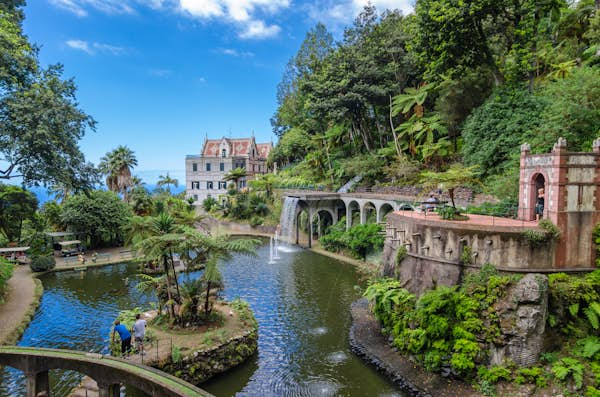A rocky, remote, formerly uninhabited island located off the coast of western Africa that belongs to Portugal, Madeira seems to relish in the extreme. Home to hardly a flat patch of land, otherworldly black pebble beaches and high-altitude trails (even the local wine is a result of challenging conditions), there's little that's typical or ho-hum about Madeira.
It's a lot to take in, and so to help you navigate this world, we've put together a list of the 10 best things to do on Madeira.

1. Ride a cable car
Madeira's rugged terrain has led to some of the world's most impressive infrastructure. It's thought that the island is home to more than 150 tunnels, and even the airport runway is essentially a bridge. But one of the most unique ways to get around Madeira is via cable cars, known locally as teleféricos.
Originally, cable cars served as a way to shift goods from some of Madeira's more isolated coastal communities inland. Today, they serve mainly to shift tourists. There are seven cable cars on Madeira, and one of the more dramatic is the Teleférico das Achadas da Cruz in Porto Moniz, said to be the steepest in Europe. The Teleférico Rocha do Navio in the north of the island, being renovated at press time, packs some absolutely astounding views of the Rocha do Navio Nature Reserve. And the cable car at Praia de Garajau is an easily accessible option that escorts visitors to a handsome black pebble beach.
2. Eat espetada
Madeira's signature dish is espetadachunks of beef that have been seasoned with coarse salt, garlic and crushed bay leaves, skewered (traditionally on bay leaf branches) and grilled over coals. The centerpiece is absolutely delicious, but we also love the sides: milho fritodeep-fried cubes of polenta and bolo de cacoa type of flatbread that's slathered with garlic butter. To serve, the espetadas are suspended on nifty devices, and pros know to position their bolo de caco below the hanging skewer so as not to lose out on any of those delicious dripping juices.
Madeira's most famous espetada restaurants are located in and around the town of Câmara de Lobos. Viola is our favorite, and serves local beef on bay leaf skewers, as well as vinho seco, a tasty locally-made wine. O Polar is inexpensive and casual, while Santo António is probably the most upscale-feeling option.
Planning tip: If you're based in Funchal, Câmara de Lobos is 10km away – an easy taxi ride.

3. Hike a levada or vereda
Centuries ago, locals on Madeira needed a way to shift water from the fecund northern half of the island to the arid southern half. To do so, they built a series of aqueducts called levadasand today there is an estimated 2500km of canals across the island. For maintenance purposes, the levadas are paralleled by walking paths, many of which have become destinations in their own right. Every day, hundreds of visitors and locals hike the levada paths, many of which pass through stunning forests and amazing vistas alike. Classic levada hikes include Levada do Furado (PR 10), which passes through a UNESCO-protected Laurisilva forest, or Levada do Risco (PR 6.1), which leads to various waterfalls.
The island is also home to more general trails, known as veredas, some of which pass through even more rugged territory. Vereda do Arieiro (PR 1) literally reaches cloud level and is thought to have some of Madeira's most impressive views, while Vereda da Ponta de São Lourenço skirts the coast – a rarity in this rugged landscape.
Planning tip: Madeira's mild climate means that levadas and veredas can be tackled at just about any time of the year.
4. Taste Madeira wine
Around 500 years ago, Portuguese explorers found that fortifying (that is, adding additional alcohol to stop the fermentation process) Madeira's wine and exposing barrels of it to hot conditions on long boat journeys actually made it taste better (not to mention more shelf stable) , and Madeira wine was invented.
Although we may think of Madeira wine as sweet or dessert wine, in terms of sweetness, it runs the gamut, with some options at the relatively dry end of the spectrum. All of the island's seven houses offer tastings, which also typically offer a tour of the facilities – often in incredibly atmospheric centuries-old cellars. Blandy's, with cellars in the middle of Funchal, is the most accessible, while we're huge fans of the brilliantly balanced (that is, more acidic-leaning) wines made by Barbeito, northwest of Câmara de Lobos.


5. Swim in a natural pool
Millenia ago, molten lava flowing into the Atlantic resulted in formations that today conveniently function as self-contained swimming spots. Some of these natural pools, as they're known on the island, retain this natural feel while others are supplemented with man-made infrastructure.
The most famous – and most built out – are the natural pools at Porto Moniz, on the island's northwestern corner. For something more rugged, head to the pools at Seixal, also located on the island's northern coast.
6. Take in contemporary art and fantastical gardens at Monte Palace Tropical Gardens
In 1987, controversial Portuguese millionaire and native of Madeira José Berardo took over a former hotel and its grounds and turned it into one of the country's most delightful contemporary art museums.
Located north of Funchal, and most conveniently reached via cable car, Monte Palace spans 70,000 sq meters on a sloping, jungle side. A handful of structures house works by domestic names such as Joana Vasconcelos but also international artists such as Willem de Kooning. These are quite possibly outshone by the grounds, which are a fantasy of fountains, themed gardens, tropical greenery and flowers, and Portugal's history told in the form of hand-painted tiles.
Detour: One way to descend from Monte is via wicker sleds piloted by drivers, a tradition that dates back more than a century.

7. Take a trip to Porto Santo
Madeira is part of an archipelago, the only other inhabited island of which is Porto Santo. Reached by a 2.5-hour ferry ride (or a hop in an airplane) from Funchal, the island has an arid, low-slung, almost desert island vibe, a strong contrast with that of its neighbor.
Most people are drawn to Porto Santo's 7.5km-long golden sand beach – considered one of the best in “Europe.” The island also has some worthwhile trails, delicious food and beautiful vistas. Despite the lack of water, Porto Santo has its own unique legacy of winemaking, with grape varietals not seen elsewhere in Portugal.
Planning tip: Porto Santo is a popular destination for domestic tourists during the summer; arrive outside of this season and you'll have the island to yourself.
8. Travel back in time at the Convento de Santa Clara
Madeira's convents were regarded as safe havens for the daughters of the nobility – strictly closed-off places where they wouldn't be exposed to the dangers of the outside world. Convento de Santa Clara, in Funchal, functioned as such for four centuries, until a recent renovation opened its doors to the public.
Inside, you'll find ancient religious art, a recreation of a nun's cell, hauntingly beautiful choirs and other spaces that were closed off to the outside world for centuries.
Detour: If exploring old residences is your thing, tack on visits to the nearby Museu da Quinta das Cruzes and Casa-Museu Frederico de Freitas, both homes formerly belonging to Madeira's wealthy class.

9. Sample Madeira's cocktails
On mainland Portugal, the cocktail is a relatively elusive thing. On Madeira, it's part of life, and the island is home to a variety of indigenous, occasionally wacky, mixed drinks.
The most famous of these is undoubtedly ponchalocally-distilled white rum, citrus juice and sugar and/or honey whipped together via a wooden whisk-like tool. Served in tiny glasses, it may not look like much and it goes down easy, but the poncha packs a disproportionate punch. Other local cocktails include the pé de cabraa combination of red wine, cocoa powder and stout that somehow works; the Nikitabeer, pineapple and ice cream blitzed in a blender; and the cortadoa combination of hot barley “coffee,” sweet Madeira wine, sugar and lemon peel drunk in the colder mountainous inland parts of the island.
Planning tip: Serra de Água, practically smack-dab in the middle of the island, is home to several poncha bars; Taberna da Poncha is probably the most famous of the lot.
10. Visit the weekend market at Santo António da Serra
Funchal's Mercado dos Lavradores gets all the press – and is worth a visit – but our pick for the island's best market is the weekend-only Mercado Agrícola Santo António da Serra.
Located in the island's western half, the small morning market is a gathering place for local farmers who bring an astounding array of produce, in particular tropical fruit, in addition to vegetables, grains, flowers, honey and other items. The market is unique in that it also functions as a social center, with many of the stalls doubling as bars or casual restaurants. Order a drink – a glass of locally-produced cider or poncha (see below) – and you'll receive a dentinho, a free snack.
Detour: If you have your own wheels, continue 3km north to Miradouro da Portela, a viewpoint from where you can gaze over a dramatic slice of the island's northern half.



